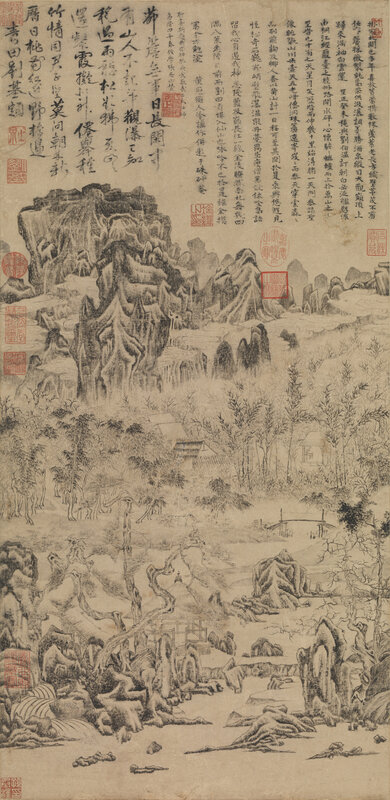Leng Qian (fl. 14th c.), Mount Baiyue, Yuan dynasty
Leng Qian (fl. 14th c.), Mount Baiyue, Yuan dynasty. Hanging scroll, ink on paper, 84.4 x 41.4 cm. © National Palace Museum, Taipei.
Leng Qian, who went by the style name Qijing and the sobriquet Longyangzi, was a native of Zhejiang. At the end of the Yuan dynasty, he went into reclusion at Mount Wu near Hangzhou. A Daoist who was also versed in music, he excelled at playing the zither. In the early Ming dynasty, he was summoned to serve the court in music and to establish music for rites. Legends about him abound in later Ming and Qing dynasty commentaries, some of which even consider him an immortal. According to the artist's inscription, he did this painting in the autumn of 1343 when he made a pilgrimage to Mount Baiyue in southern Anhwei with Liu Ji (1311-1375) via the sea route. In addition to making offerings, they also traveled and enjoyed the landscape. Viewing the beautiful scenery in nearby areas, they took advantage of the proximity to Huangshan to visit that famous scenic site. After their return, Liu Ji asked Leng Qian to record their travels with a painting, which Liu also inscribed as a complement. This painting is an actual record combining travel, pilgrimage, text, and image, which is not often seen in Chinese art, making it a particularly early example. Coming from the hand of a Daoist skilled in the arts of alchemy, it seems to take on an even greater aura of mystical transformation. Concerning another painting in the National Palace Museum and this website (i.e., "Angling Terrace at Yanling"), it was done by Sa Dula as a record of his trip with Leng Qian to another famous mountain in Zhejiang. The coming together of friends to admire mountainous scenery and record their travels in painting perhaps was common in the circle of friends that Leng Qian associated. It also may have been related to his view of nature in Daoism.
Leng Qian was not famous for his skills in painting and it is difficult to discern from his works the connection between his methods and traditional methods. Here, he depicted all sorts of craggy pines and strange rocks in a myriad of poses along with a waterfall half concealed in the pervasive mist , creating an eerie and archaic feeling. His technique was quite plain. He used scorched ink and dry brushwork to create mountains and pine trunks with a rough texture. He used the white background color of the paper to represent mountain ridges, creating a strong contrast between black and white, solid and void. It is almost as if he wanted to capture the visual effect of light striking the forms as well as the shapes and textures of the rocks and trees. Leng Qian did not use the "vocabulary" of painting that was common at the time, ultimately opening a new direction in the painting of landscape as a record of travel. (Text from National Palace Museum, Taipei).

/https%3A%2F%2Fprofilepics.canalblog.com%2Fprofilepics%2F1%2F0%2F100183.jpg)
/https%3A%2F%2Fstorage.canalblog.com%2F03%2F02%2F119589%2F96711876_o.jpg)
/https%3A%2F%2Fstorage.canalblog.com%2F11%2F31%2F119589%2F94773502_o.jpg)
/https%3A%2F%2Fstorage.canalblog.com%2F20%2F83%2F119589%2F94772815_o.jpg)
/https%3A%2F%2Fstorage.canalblog.com%2F26%2F72%2F119589%2F75604929_o.jpg)
/https%3A%2F%2Fstorage.canalblog.com%2F59%2F60%2F119589%2F26458628_o.jpg)





/image%2F1371349%2F20240423%2Fob_b2fe42_telechargement-9.jpg)
/image%2F1371349%2F20240423%2Fob_af8bb4_telechargement-6.jpg)
/image%2F1371349%2F20240423%2Fob_b6c4a6_telechargement.jpg)
/image%2F1371349%2F20240423%2Fob_981d5f_h22891-l367411650-original.jpg)